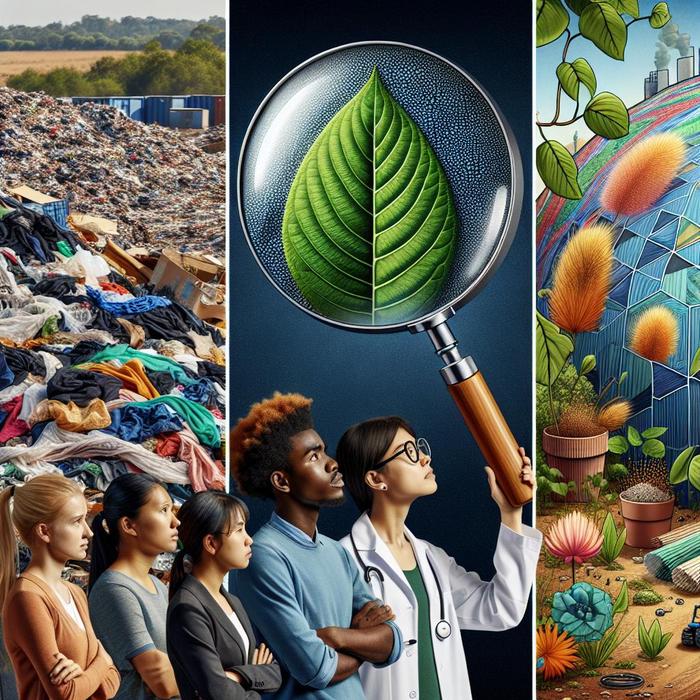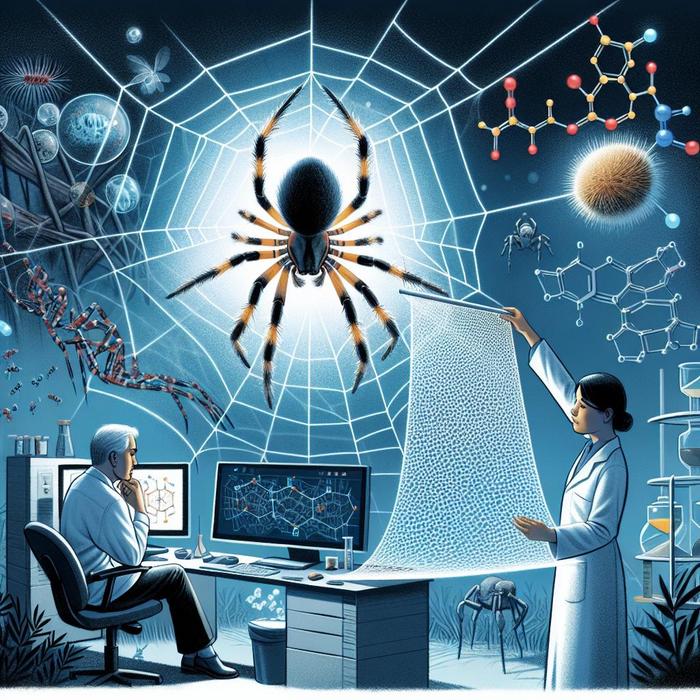What if Nature Could Solve Our Textile Waste Problem?
Imagine stepping into a world where there were no waste bins overflowing with discarded clothes, no landfills brimming with unused textiles, and no chemical pollutants seeping into our water sources due to synthetic textile production. Seems far-fetched? Perhaps not, if we turned to nature for solutions. Biomimetic materials, inspired by nature’s own designs, could well be the resolution to our textile waste problem.
Transforming the Textile Industry with Biomimicry
A striking shift is sweeping across the textile industry, and it all revolves around the principles of biomimicry, or as some experts call it, “biomimeting”. This transformative method of design, derived from the natural world, has the potential to revolutionize the way we make, use, and ultimately dispose of textiles.
A world where textile waste is no longer an environmental concern may not be as far away as you might think. Some innovative minds are already looking to nature, exploring ways to mimic its efficiency and sustainability in the textile industry. Biomimetic materials offer a radical new way of resolving textile waste, shifting our reliance from non-renewable resources to nature’s own materials and processes.
Learning from Nature, Transforming Our Approach
Nature is a prolific innovator, with millions of years of research and development experience under its belt. By observing and learning from natural structures and processes, humans can develop more sustainable and efficient ways of producing textiles.
Turning to biomimicry for textile innovation doesn’t just mean looking at the materials we use – it also means rethinking how we produce and dispose of these materials. By mimicking natural cycles, we can make sure that textile waste is not ‘waste’ at all, but a valuable resource to be used again and again.
Moving from Linear to Cyclical Models
Nature operates in cycles. A tree shedding its leaves in autumn doesn’t create waste – those leaves decompose and enrich the soil, providing nutrients for new growth. This cyclical model is a sharp contrast to the linear ‘take-make-waste’ model that most modern industries, including textiles, currently employ.
According to biomimetic design principles, transforming the textile industry requires moving from this linear model to a more circular one. In this system, textiles would be designed and produced so that at the end of their life, they can be fully repurposed or broken down naturally, mimicking nature’s own waste management system.
Inspiring Examples of Biomimicry in the Textile Industry
The dream of a zero-waste textile industry is not so far-fetched, with several inspiring examples of biomimicry in action. For instance, certain companies are developing textiles inspired by the lotus leaf, which has a natural self-cleaning property. Others are turning to biomimicry engineering to create biodegradable textiles inspired by the structure of spider silk.
These biomimetic materials and processes signal a significant shift towards a more sustainable, waste-free textile industry. The beauty of these designs is that they are not just inspired by nature – they also respect and protect it, aligning with ecological principles rather than working against them.
Embracing Biomimicry, Transforming Our Future
Biomimicry has already begun to transform various industries. By embracing biomimicry, the textile industry has the potential to solve one of its most persistent and significant challenges – textile waste. Through innovative biomimicry engineering and the development of biomimetic materials, we can look forward to a future where textiles align with the principles of nature, promoting sustainability and eliminating waste.
Remember, however, that such transformation doesn’t depend solely on industry leadership. As consumers, our choices also have a significant impact. By choosing textiles that employ biomimetic design principles, we can propel this shift towards sustainability and play our part in resolving textile waste problems.
So, can nature solve our textile waste problem? With biomimicry, it seems very possible indeed.
How Close Are We to Realising This Sustainable Future?
As promising as these advances in biomimicry seem, how close are we to truly achieving this sustainable future, where nature’s genius reigns supreme and waste becomes a distant memory. Remarkably, thanks to rapid developments in biomimetic research and engineering, that future might be closer than we think. As consumers demand more sustainable options, many textile companies are recognizing the inherent advantages of embracing biomimicry.
While many transformative innovations are already in progress, there are still hurdles to overcome. Scaling technologies that reimagine traditional industry processes is always a monumental task. However, significant funding programs such as the one provided by the European Commission’s Horizon Europe programme, which focuses on research and development of biomimetic and bioinspired materials, offer hope that these obstacles can be surmounted.
What Changes Can We Expect in the Industry?
As the transformation towards biomimicry continues to gather pace, the textile industry could undergo some profound changes. There will likely be a shift towards naturally-derived materials, coupled with an increased emphasis on design processes that mimic nature’s cycling of resources, thereby reducing waste.
Moreover, this shift towards nature’s methods will probably result in a reduction in the use of harmful chemicals. Companies are already investing considerable resources in biomimicry research to differentiate themselves and fulfil their sustainability promises, giving a clear indication of the substantial impact biomimicry is set to have on the textile industry. It’s a trend well worth watching closely.
Unlocking Prosponsibility Through Biomimicry
Often, discussions around sustainability focus on responsibility – what industries and individuals should do to limit their negative impact on the environment. This perspective, although essential, sometimes ignores an equally important concept: ‘prosponsibility’—specifically, what can we actively do to contribute positively to our environment?
Through biomimicry and the application of biomimetic materials, both industry and consumers have an opportunity to embody this notion of prosponsibility. For example, adopting biomimicry-based practices within the textile industry facilitates a shift from a linear, wasteful model to a circular, sustainable one. This shift doesn’t merely reduce harm; it can contribute to the overall health of our ecosystems.
A New Textile Era: Realising the Potential of Biomimicry
Harnessing the ingenious designs and processes found in nature is far from a superficial trend. On the contrary, biomimicry heralds a new era in sustainable and efficient textile production. Biomimicry’s potential to revolutionize the industry—from minimizing waste to reducing chemical pollutants—is tangible and transformative.
Sustainable brands like Pangaia are already leading the way, using biomimicry to address the industry’s environmental challenges. Many are incorporating biomimetic designs into their products, and others embracing biomimicry engineering to influence procedural changes in their operations.
The complexities that these transformative shifts bring should not be underestimated. However, progressive companies and institutions, as well as proactive governmental bodies, are not shying away from the challenges. The momentum towards a future where biomimicry underpins the textile industry’s operations grows stronger by the day.
Creating a Positive and Sustainable Future through Biomimicry
What does this mean for the future of the textile industry? If the current trajectory of innovations and commitment to biomimicry continues, the sector could become a leading example of sustainable and responsible industry practices. Moreover, it could play a pivotal role in tackling not just the textile waste problem but many of the environmental challenges our planet currently faces.
As experts explore the potential of biomimicry engineering further, from harnessing the properties of spider silk to reduce wasteful production processes, to the replicating self-cleaning properties of lotus leaves to decrease pesticide use, there is increased hope of creating a future where the textile industry truly operates hand in hand with nature.
To play our part in this potential future, we can support organisations, such as Biomimeting, dedicated to promoting this transition towards sustainable textile production methods.
The move towards biomimicry in textile industry doesn’t just represent a shift in our approach towards the environment; it exemplifies a transformation in our thinking. Recognising that nature has invaluable lessons to teach us, and knowing how we can apply these lessons, offers us a greater opportunity to build a sustainable future. Does this mark the end of ‘waste’ in the textile industry and revolutionise how we perceive and approach waste across other sectors? Only time will tell, but the seeds have already been planted.
Moreover, while it’s easy to focus on the environmental benefits, we shouldn’t overlook another essential aspect: biomimicry also offers an economic opportunity. The transition to sustainable practices brings innovation and new technologies, results in job creation and benefits all sectors, from health care to construction.
Understanding Biomimicry: Nature’s Wisdom at Our Fingertips
By understanding and applying the principles of biomimicry, we open ourselves to the wisdom that nature has developed over millions of years. This valuable knowledge can help us tackle fundamental industrial production issues and encourage us to become conscious designers and caretakers of our world.
To fully comprehend our potential in this journey, we must embody an attitude of deep respect and awe for nature and recognise that the solutions to some of our most pressing problems may lie right in front of us. Looking closely at our natural environment, it becomes evident that solutions to long-standing issues such as textile waste are within our reach.
By exploring the intricate systems and structures found in nature, we may just find the inspiration to create a world where waste is not a by-product but a valuable asset. In this context, biomimicry holds the key to unlocking a future where nature and industry exist in synchrony, creating true sustainability – economically, socially, and environmentally.
The Biomimicry Revolution: A Manifestation of Positive Change
The revolution that biomimicry is bringing about in the textile industry is far from an isolated event. It serves as a snapshot of the broader shift towards sustainable practices occurring across various industries. The message is loud and clear: biomimicry is not just an abstract concept but a practical tool for positive change.
If we can encourage society to appreciate nature’s wisdom and openness to learning from it, we may yet navigate towards a sustainable future where waste is an antiquity. Ultimately, the question is not one of possibility, but of choice: Will we choose to learn from nature’s wisdom and utilise the principles of biomimicry to overcome our current sustainability challenges? If the advancements in the textile industry are anything to go by, then the answer is an encouraging “yes.”
Thus as we look towards the future, there is a firm sense of optimism. While challenges undeniably lie ahead, the transformative power of biomimicry offers tangible hope and a sustainable roadmap. As we continue this exciting journey, uniting engineering, ecology and design to manifest a more sustainable tomorrow, it’s a good time to ask – where else might biomimicry lead us?
As we explore the concept of biomimicry, now is the time to extend our curiosity and open ourselves to learning. Indeed, every effort should be made to understand this unique approach that nature has to offer. Through this exploration, we can not only confront and mitigate environmental challenges, but also ensure that our practices align with the principles of long-term sustainability and environmental respect. The future is biomimicry; it’s time to embrace it.

